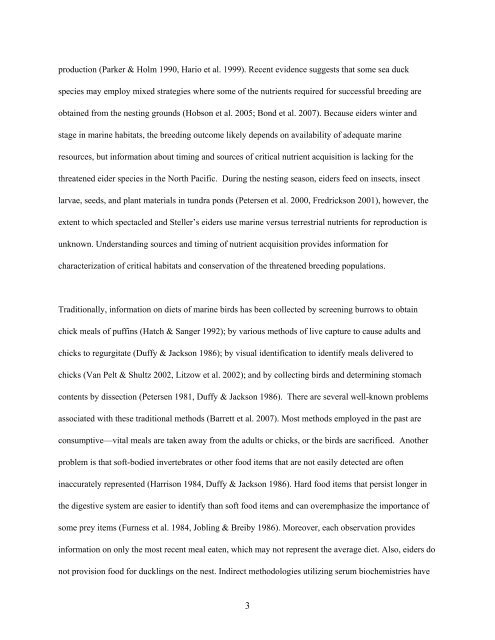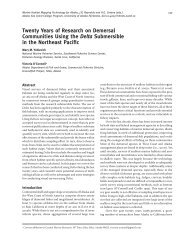724_Final Report.pdf - North Pacific Research Board
724_Final Report.pdf - North Pacific Research Board
724_Final Report.pdf - North Pacific Research Board
Create successful ePaper yourself
Turn your PDF publications into a flip-book with our unique Google optimized e-Paper software.
production (Parker & Holm 1990, Hario et al. 1999). Recent evidence suggests that some sea duck<br />
species may employ mixed strategies where some of the nutrients required for successful breeding are<br />
obtained from the nesting grounds (Hobson et al. 2005; Bond et al. 2007). Because eiders winter and<br />
stage in marine habitats, the breeding outcome likely depends on availability of adequate marine<br />
resources, but information about timing and sources of critical nutrient acquisition is lacking for the<br />
threatened eider species in the <strong>North</strong> <strong>Pacific</strong>. During the nesting season, eiders feed on insects, insect<br />
larvae, seeds, and plant materials in tundra ponds (Petersen et al. 2000, Fredrickson 2001), however, the<br />
extent to which spectacled and Steller’s eiders use marine versus terrestrial nutrients for reproduction is<br />
unknown. Understanding sources and timing of nutrient acquisition provides information for<br />
characterization of critical habitats and conservation of the threatened breeding populations.<br />
Traditionally, information on diets of marine birds has been collected by screening burrows to obtain<br />
chick meals of puffins (Hatch & Sanger 1992); by various methods of live capture to cause adults and<br />
chicks to regurgitate (Duffy & Jackson 1986); by visual identification to identify meals delivered to<br />
chicks (Van Pelt & Shultz 2002, Litzow et al. 2002); and by collecting birds and determining stomach<br />
contents by dissection (Petersen 1981, Duffy & Jackson 1986). There are several well-known problems<br />
associated with these traditional methods (Barrett et al. 2007). Most methods employed in the past are<br />
consumptive—vital meals are taken away from the adults or chicks, or the birds are sacrificed. Another<br />
problem is that soft-bodied invertebrates or other food items that are not easily detected are often<br />
inaccurately represented (Harrison 1984, Duffy & Jackson 1986). Hard food items that persist longer in<br />
the digestive system are easier to identify than soft food items and can overemphasize the importance of<br />
some prey items (Furness et al. 1984, Jobling & Breiby 1986). Moreover, each observation provides<br />
information on only the most recent meal eaten, which may not represent the average diet. Also, eiders do<br />
not provision food for ducklings on the nest. Indirect methodologies utilizing serum biochemistries have<br />
3



